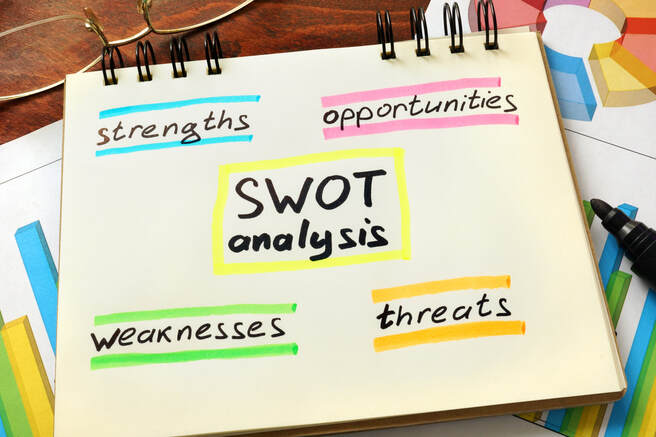|
If you’re not already familiar with the SWOT acronym, it stands for Strengths, Weaknesses, Opportunities, and Threats. A lot of people talk about conducting a SWOT analysis when starting or rebranding a for-profit business, but it’s just as important for nonprofits to take stock of these things in their industry as well. Like a for-profit business, nonprofits have a lot they want to accomplish for their communities but limited resources with which to accomplish them. A SWOT analysis can help you understand how to make the most of those resources so you can have the biggest possible impact on your community. Before we talk specifically about how to use a SWOT analysis for nonprofits, let’s take a closer look at what a SWOT analysis is: What Is a SWOT Analysis?Strengths are all the things you have working for your organization and its overall goals. This could include everything from your staff and volunteers to your strategic location to your partnerships with other organizations. Weaknesses are the things that could hinder your ability to reach your goals, such as a limited budget, a high turnover rate, employees who are overworked and undermotivated, etc. Opportunities are things happening outside your organization you can exploit to reach your goals. Did something happen in the news that could motivate people to donate to or volunteer at your organization? Keeping an eye out for opportunities your nonprofit can exploit is key to achieving your goals, but keep in mind they can be both ongoing and temporary opportunities. This is why you should do a SWOT analysis on a regular basis (once or twice a year) instead of just once. Threats are the external forces that could hold you back from achieving your goals. Changes to laws that regulate your nonprofit or changes in tax laws that could inhibit people’s willingness to donate are examples of things happening outside your organization that could impact your ability to reach your goals. Keep in mind, these are not excuses not to achieve your goals. Rather, by taking stock of these threats, as well as your strengths and opportunities, you can identify ways to succeed despite the threats facing your organization. How to Use a SWOT Analysis for NonprofitsNow that we have a clear idea of what a SWOT analysis is, let’s go over some ways you can use it to leverage your strengths and opportunities so you can mitigate your weaknesses and overcome your threats. Investigate Each Item in Your SWOT Analysis for NonprofitsIt’s not enough to identify your strengths, weaknesses, opportunities, and threats and call it a day. You need to investigate each item on your list so you can get down to its root cause. Why is it happening? How is it currently affecting your business? Are you taking full advantage of your strengths and opportunities? Have they already mitigated weaknesses and your threats? Ask AroundA SWOT analysis for nonprofits is something you should never undertake on your own. Get some team members together so you can all brainstorm items to put on your SWOT analysis. Even volunteers might have some things you had not previously considered because they get to see your organization from a different perspective. The more people you can include in a SWOT analysis for nonprofits, and the greater diversity of perspectives you can bring to the table, the stronger your analysis will be. Be Brutally Honest When Conducting a SWOT Analysis for NonprofitsIt can be tempting to focus on your strengths and opportunities, but your weaknesses and threats won’t go away just because you ignore them. Your strengths and opportunities are not there to make you feel good - they are there to help you mitigate weaknesses and threats so you can achieve your goals. Take Your TimeIf one of your threats is a lack of time to accomplish all the things on your to-do list, you’re not alone, but don’t use that as an excuse to not conduct a SWOT analysis for your nonprofit, or to rush through the process without fully investigating each item that pops up in your analysis. Investing the time to do a SWOT analysis for nonprofits can save you time and money for months, if not years to come as you identify strategies that aren’t working and programs that could use more resources so they can have a bigger impact on your community. Get Comfortable with the NumbersIf you’re a numbers person, this part shouldn’t be too difficult for you, but if you’re more verbally oriented and you tend to shy away from the numbers, it’s important to know that getting comfortable with your numbers is key to conducting a successful SWOT analysis for nonprofits. Only by looking critically at the numbers can you know for sure whether an investment is generating a return or just sucking up time and money. Be Willing to Think Outside the Box
Whether you need help conducting a SWOT analysis for nonprofits, or you’ve conducted one but you’re not sure how to make the most of the data, I can help. You can schedule your FREE clarity call now so we can discuss how I can help you make the most of your nonprofit’s strengths and opportunities to mitigate weaknesses and threats.
0 Comments
Leave a Reply. |
Why Morsels?Business advice, 
Please tell me how you found me
Archives
June 2022
Categories |
|
Office: 815-524-4307
|



 RSS Feed
RSS Feed




